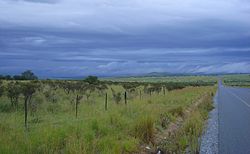Middledrift
Middledrift
iXesi Middeldrift | |
|---|---|
 Landscape near Middledrift | |
| Coordinates: 32°49′7″S 26°59′15″E / 32.81861°S 26.98750°E | |
| Country | |
| Province | |
| District | Amathole |
| Municipality | Raymond Mhlaba |
| Area | |
• Total | 1.84 km2 (0.71 sq mi) |
| Population (2011)[1] | |
• Total | 2,140 |
| • Density | 1,200/km2 (3,000/sq mi) |
| Racial makeup (2011) | |
| • Black African | 95.9% |
| • Coloured | 2.1% |
| • Indian/Asian | 0.3% |
| • White | 0.8% |
| • Other | 0.8% |
| First languages (2011) | |
| • Xhosa | 86.7% |
| • Afrikaans | 5.2% |
| • English | 3.8% |
| • Sign language | 1.0% |
| • Other | 3.3% |
| Time zone | UTC+2 (SAST) |
| Postal code (street) | 5685 |
| PO box | 5685 |
| Area code | 046 |
Middledrift, officially known as iXesi (in Xhosa) and also known as Middeldrift (in Afrikaans), is a small town located 90 kilometres (60 mi) north-west of East London in the Eastern Cape province of South Africa. It is situated in Raymond Mhlaba Municipality in Amathole District in an area that was formerly part of the Ciskei.
The town is on the Keiskamma River, 45 km west-north-west of King William's Town and 16 km east-south-east of Alice. It was founded in 1853 and laid out in 1882. At first known as Beaconsfield, it was renamed after its situation at a ford (Dutch: drift) between two others. Due to corruption and mismanagement of funds it has become a wasteland and most of the residents nearby have to travel to Alice for shopping and services.[2] The town is the birthplace of anti-apartheid activist Wilton Mkwayi, advocate Bulelani Ngcuka,book author Noni Jabavu and scientist Dr Vatiswa Papu Zamxaka.
References
[edit]- ^ a b c d "Main Place Middledrift". Census 2011.
- ^ "Dictionary of Southern African Place Names (Public Domain)". Human Science Research Council. p. 309.




